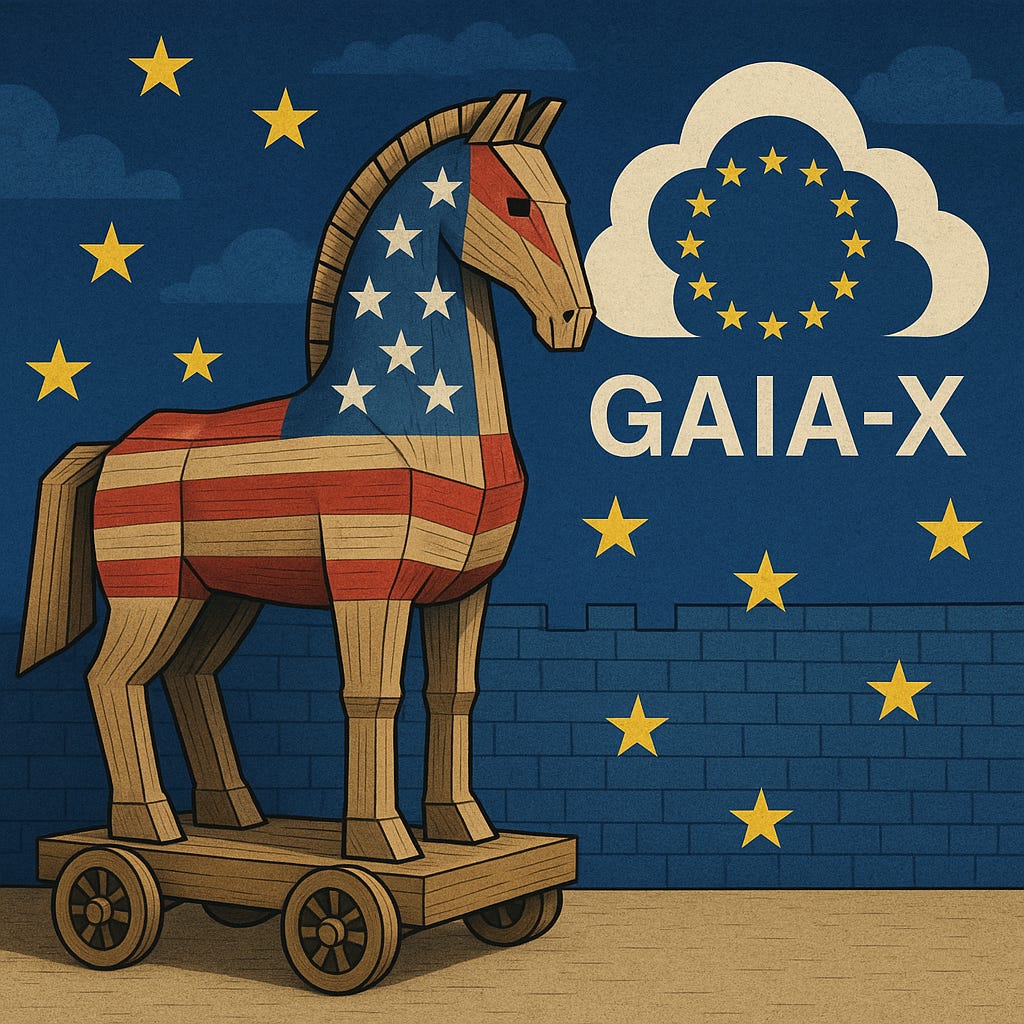Will the EU's AI Gigafactories become a white 🐘?
The AI gigafactory project can learn some lessons from previous cloud aspirations
Cloud computing is dominated by American companies and a couple of years ago Europe tried to remedy this though something called “Gaia-X”. In a striking parallel today, the burgeoning AI sector is also dominated by American (and Chinese) companies. In response, the European Commission is now rolling out “AI Gigafactories”. In this newsletter I’ll explain what both of these initiatives are and ask how the new Gigafactories can avoid the troubled fate of Gaia-X.
“Breaking American dominance in cloud computing”
Where the U.S. has Amazon Web Services, Microsoft Azure and Google Cloud, the E.U. has no equivalent cloud computing provider of any comparable size. Indeed, no European company makes the global top 10 by market share. The implication of this dynamic is that European governments and companies inevitably depend on foreign actors for data storage and processing. Body camera footage collected by German federal police officers, for example, is stored on Amazon servers.
Back in 2019, the German government in particular sought to end European cloud dependence by working to make their data “sovereign”, which was then defined as data secured against foreign spying and safe from being cut off for political reasons. The ultimate aim was to allow Europe and Germany’s digital infrastructures to run independently if foreign cloud providers would stop cooperating, and - in the words of the then French digital minister Bruno Le Maire - to “break the dominance of American companies in cloud computing.”
Gaia-X was born on the back of this political momentum. When the project was unveiled, the German Economy Minister Peter Altmaier described it as a key tool for Europeans to “assert ourselves in the world”. The basic idea was that Gaia-X, a private company backed by European governments and existing cloud providers, would formulate a set of standards that would enable easy switching between a wide range of cloud providers. In turn, the hope was that this would make it easier for European market entrants to offer a competitive product based on these common standards. In the words of the German minister: “No one knows if Gaia-X will lead to a new hyperscaler within some of the participating companies like SAP or Deutsche Telekom. (...) we expect the amount of data that needs to be stored to grow exponentially in the coming years and decades, which will allow several companies to prosper”.
Like IKEA, cloud providers have no competitors
As far as I can tell, Gaia-X has achieved nothing for European data sovereignty in the five years that it has been around. Three main factors seem to have driven this failure. Firstly, American cloud providers built a beautiful Trojan horse and Gaia-X was to drag the horse right through the gates and inside the walls. Major foreign players, such as Amazon, Huawei, Microsoft, Alibaba Cloud, Google, IBM and even U.S. defence firm Palantir were allowed to join the project as members despite having an active interest in seeing it fail.

Secondly, as my fellow Dutchman Bert Hubert pointed out in an excellent analysis, a cloud provider is a bit like the Swedish furniture company IKEA. You go to IKEA because you know they have “everything your households needs, including meatballs.” If you want to be anything other than a niche player in IKEA’s market, you have to show up out of the blue with the same impressive offering and at a similar price point as the market leader. Competitors who’ve tried, have all gone bankrupt.
The major cloud providers in the market today provide data storage, databases, email, video streaming and AI systems. If you’d want it, Amazon even allows you to rent a satellite ground station or a private 5G network (!). Just like an IKEA competitor with only half the offering cannot compete, European cloud providers like Exoscale and UpCloud lack the scale to provide the same attractive range of services to customers.
Thirdly and finally, Gaia-X lacked a precise and comprehensible objective that everyone was working towards, and against which progress could be measured. The project’s website lists multiple and competing aspirational statements, claiming that Gaia-X “strives for innovation through digital sovereignty” and that it “is a federated system linking many cloud service providers and users together in a transparent environment that will drive the European data economy of tomorrow.” Obviously no one knows exactly what a European data economy of tomorrow actually is and I doubt that this vagueness helped achieve results.
AI Gigafactories
Spurred on by President Trump’s January “Stargate” announcement to invest up to 500 billion USD in computing power, European Commission President von der Leyen announced at the Paris AI Summit in February that the EU would establish three to five “AI Gigafactories”. The stated goals for this project are to enhance European economic competitiveness and to strengthen its sovereignty as a bloc.
The EU’s Gigafactories are essentially data centres consisting of at least 100,000 graphic processing units (GPUs, the chips that power AI training), and will upgrade some of the 13 previously announced regular AI factories that will house up to 25,000 GPUs each. The funding source for these Gigafactories is, as of yet, murky. The Commission seems to have earmarked 980 million euro in funds for all of the factories combined, which when matched by hosting Member States would amount to a total budget of just under 2 billion euros.
Some Gaia-X lessons
The EU would do well to study lessons from the Gaia-X project before finalising its AI approach, but the first signs are not looking promising. Firstly, European trade Commissioner Šefčovič again seems set to invite in foreign companies before Europe’s own strategy has fully crystallised. In a visit to Singapore last week, Šefčovič claimed the US and the EU “have the same interest” in the field of AI. This statement would seem to be at odds with the White House objective of enhancing American AI dominance.
Secondly, business partners OpenAI and Microsoft lead together, taking a market share of almost 50% between them, and a mature AI market could well end up looking as anticompetitive as the current cloud market is. In this scenario, it will require a herculean effort to build something that can rival the market leader. With Microsoft alone having committed to an 80 billion dollar investment this year, the total European commitment of 2 billion euro pales in comparison. The total European budget will only get you about 80,000 of Nvidia’s cutting-edge AI chips at 25,000 USD a piece, which would see the EU struggle to reach its own Gigafactory threshold; let alone scale to the level that it can rival a market leader.
Thirdly and most importantly, the stated objectives of the Gigafactories are insufficiently precise. There is, for example, too much ambiguity about whether the EU is pursuing a mostly public or mostly private option. On the one hand, the Commission’s announcement of “InvestAI”, aiming to mobilise 200 billion euro in private sector investment, seems to try and replicate Silicon Valley’s approach of scaling computing power through ever growing sums of corporate investment. On the other hand, the InvestAI press release also heavily references a CERN for AI model. CERN, the Geneva-based particle physics lab, is almost entirely funded by government contributions and advances humanity’s scientific understanding. This analogy implies a very different vision for the eventual AI Gigafactory project.
The Gigafactory policy announcement is only a month old and this would suggest that there is still time to refine and pivot. The failure of Gaia-X tells a cautionary tale and the Commission would do well to critically evaluate AI Gigafactories plans in this light. Success requires some honesty about when geopolitical interests diverge, a clear idea of what the business model is going to be, and a consistent vision of what the Gigafactories should (and should not) be expected to achieve.
Meme Graph of the Month
The causes of the fall in hiring shown below are all but clear, but it seems likely that AI-powered coding played at least some role in companies’ decisions to drastically reduce hiring of software engineers.
Suggested reading
In a pretty unique piece of good news, Singapore led a convening of leading AI researchers from key companies, academia and AI Safety Institutes in late April in preparing a blueprint of what AI safety research can be usefully carried out across geopolitical divides. This Wired piece on Singapore is a great read.
“AI 2027” caused a sensation in my bubble and, if you live in that bubble as well, you are unlikely to have missed it. The piece describes in detail how the development of AI may play out, and how it will upset relations between the U.S. and China.
My final recommendation is this very readable Guardian piece on what happens when AI replaces us at work and in our most intimate relationships: “It will be hard to justify spending twice as much for a human therapist, lawyer or teacher who’s only half as good. Organisations that choose slow, expensive humans will be outcompeted by those who choose fast, cheap, reliable AI.”
Thanks for reading. Please consider making this newsletter findable to others by clicking the like button below or by forwarding it to someone who might enjoy it.
Also please do keep the feedback coming, it remains welcome through mark [at] future of life [dot] org.





